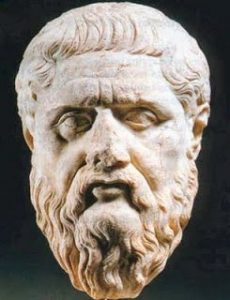(2014-2015)
“Andreia Pinto-Correia calls her new orchestral work Timaeus, titled after Plato’s dialog, a “concerto for orchestra,” creating dialogs and oppositions among the ensemble’s sections and solo roles (the harp is particularly prominent) as a way of generating energy and contrast. The piece also shifts in focus between amorphous, static moments, such as the opening, to mosaics of clearly defined gesture—that is, between two perspectives on the articulation of time, which is the subject of “Timaeus” as well as of the Elliott Carter lecture the composer references in her own notes on her piece…”
-Robert Kirzinger, Boston Symphony Orchestra, Assistant Director of Program Publications
_______________________________________________________________________________________
 Timaeus, written by Plato (c. 427-347 BCE) is considered to be the first manifesto of teleology. This late and complex dialogue gives an account of the creation of the cosmos, and of a craftsman god who imposes order on a pre-existing chaos. The explanation is supported by Plato’s mathematical and geometric formulas.
Timaeus, written by Plato (c. 427-347 BCE) is considered to be the first manifesto of teleology. This late and complex dialogue gives an account of the creation of the cosmos, and of a craftsman god who imposes order on a pre-existing chaos. The explanation is supported by Plato’s mathematical and geometric formulas.
My composition Timaeus is divided into three main movements (The Work of Reason, The Work of Necessity, The Work of Reason and Necessity), bracketed by an introduction and a coda. A concerto for orchestra, it is about twenty minutes in duration and follows the main sections of Plato’s text. The elements fire, earth, water, and air are each represented by a distinct group of soloists that features a particular harmonic and timbral profile. The musical narrative is built upon the interactions between these instrumental groups; they are in constant flux, mirroring the complex narrative of the text. The work was inspired by Elliott Carter’s Time Lecture (1965/94) and consequently was written in memory of the acclaimed composer whom I met during my Tanglewood Fellowship in 2009.